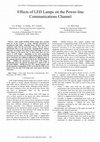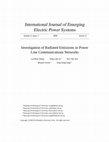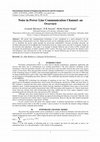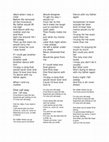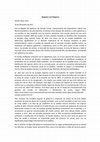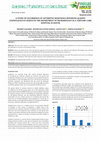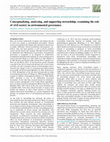Effects of Plasma Lamps on the Power-line
Communications Channel
Ashraf Emleh 1, Arnold de Beer 1, Hendrik Ferreira 1, Adrianus Han Vinck 2
1
Department of Electrical and Electronic Engineering Science, University of Johannesburg, P.O. Box 524, Auckland Park, 2006,
South Africa
2
Institute for Experimental Mathematics, Duisburg-Essen University, Ellernstr. 29, D-45326, Essen, Germany
aemleh@uj.ac.za
Abstract— Plasma is one of the states of matter. The other
states of matter are liquids, solids and gases. Plasma is used in
television, neon signs and fluorescent lights. Stars, lightning,
aurorae and most flames consist of plasma. Although energy
effective, they inject conductive noise into the power-line system.
This can have a detrimental effect on the power-line
communications channel. This paper investigates these effects
when plasma lamps are seen as noise sources on the power line. It
is shown that in the CENELEC band: (3kHz – 150kHz) the
interference level from Plasma lamps is significantly below the
allowed maximum PLC signal levels. In the band 150kHz –
30MHz however, PLC signals compete with Electromagnetic
Compatibility (EMC) levels and the SNR can be equal to zero,
but only if the lamps have active power electronic converters.
Keywords— Plasma, Lamp, Power-line Communications, PLC,
Interference, EN 50065-1, EMC.
I. INTRODUCTION
The well-known plasma lamps design was invented during
the 1970's by a MIT student named Bill Parker [1];
nevertheless, the original plasma lamps were first created by
Nikola Tesla [2] while studying the effects of high frequency
current discharged into low pressure gases contained by a glass
tube.
Plasma lamps come in different constructive design and
shapes, globes, domes, orbs and other, but they all work on the
same basic principle. They can be usually found in the shape of
a clear glass orb, containing a mixture of low pressure gases
such as xenon, krypton and neon, although the gaseous mix is
not preferential. The other glass shell houses a much smaller
glass orb that has the role of the electrode. High frequency,
high voltage alternating current is being pumped into the
electrode with the help of a high voltage transformer.
A standard plasma lamp device uses an electric current
having an oscillating frequency of 35kHz and a voltage
ranging from 2 to 5 kilovolts. As the lamp is being powered,
the gas mixture inside it is ionized and gives rise to multiple
beams of colored light discharges extending from the inner
glass orb to the outer glass container. The outer glass orb can
heat up to dangerous temperatures, not enough to determine a
failure of the device but sufficient to cause light burns. Plasma
lamps are ideal sources of static charge that could determine a
high voltage discharge even through the plastic protective
casing. Because they use high-frequency electric currents to
obtain the desired effects, plasma lamps present a series of
potential hazards to the operators and other electrical devices
widely used today. The high frequency of the current,
respectively 35 kilohertz, produces parasite frequencies in the
radio spectrum that could affect the operation of several house
appliances such as the touch pad of a laptop or the correct
functioning of several other digital devices.
The procedure of the measurements was made to comply
with CENELEC narrowband rules in one case, and to serve the
broadband signals in the other case [3].
II. MEASUREMENT SET-UP
The measurement set-up used is shown in Fig.1. A plasma
lamp is supplied with 9000VAC through a 220VAC isolation
transformer, Line Impedance Stabilization Network (LISN) and
a step-up transformer. The isolation transformer is used as the
LISN causes an earth-leakage current to flow that trips the
supply. Floating the LISN rectifies this fault condition. The
LISN as used in this set-up has two functions:
x Firstly, it filters noise from the AC supply. The
measurement side (current probe and plasma lamp in
Fig. 1) is therefore clean from any noise on the powerline and an accurate assessment of the noise produced
by the plasma lamp can therefore be made. A clean
50Hz 220VAC is supplied to the step-up transformer
that supplies the plasma lamp with 9000VAC.
x Secondly, it supplies a standardized noise load to the
conducted interference created by plasma lamp. At
higher frequencies (typically > 1MHz) the noise load
impedance presented by the LISN (and seen by the
plasma lamp) is 50Ω.
Measurements and conclusions in this paper are made for
two regions of the emission spectrum:
x 3kHz – 150kHz: This is the frequency range of the so
called CENELEC bands as defined by EN 50065-1 [4].
Measurements for these bands were made in the time
domain and a Discrete Fourier Transform (DFT)
performed to obtain harmonics in the frequency
domain. A Tektronix DPO7254 oscilloscope and
Tektronix TCP0030 current probe were used. It was
assumed that the Common Mode (CM) currents are
negligible in this band and that all interference is in
Differential Mode (DM) – an assumption also used in
EN 50065-1. Results were downloaded to a PC for
processing. This is shown in Fig. 1.
th
55 International Symposium ELMAR-2013, 25-27 September 2013, Zadar, Croatia
125
�Figure 1. Set-up for measurements in the 3kHz – 150kHz range.
150kHz – 30MHz: This is the frequency range for
Broadband PLC. It spans the range traditionally used
to measure conducted emissions as per CISPR-22 [5].
In this case, measurements in the frequency domain
were directly made using a Rhode & Schwarz FSH323
Spectrum Analyzer and ETS-Lindgren 94111-1L
1GHz bandwidth current probe. Since interference on a
PLC system occurs in DM, a special arrangement of
cables with respect to the current probe was used for
measuring in this range. This special arrangement can
be seen in Fig. 2. It cancels the CM current and
measures the DM only.
x
Figure 2. Set-up for measurements in the 150kHz – 30MHz range.
The circuit of the second type of plasma lamps is basically
220VAC in a 25.2V step down transformer, into a full wave
bridge rectifier, and a large filter capacitor, which gives over
25.2V DC at just under 2 amperes in the primary side of the
circuit with no load. The capacitor is necessary as it charges
during the peak of the AC cycle, and releases during the trough.
This voltage charges the primary coil and consequently the
ferrite core of the transformer, which induces a charge in the
"feedback" coil, which turns off the transistors. When the
transistors have stopped conducting the power is rerouted
through the resistors. The EM field in the ferrite core then
collapses with no charge to support it, which induces a large
high voltage spike in the secondary coil in the reverse direction
(basic laws of inductors). The transistor then begins to conduct
again because there is no longer any current in the feedback
winding, which causes the DC input to oscillate AC, out from
the secondary at a high frequency like 15-40 kHz, and around
10-25kV output. Diodes can be used as a safety device to keep
high voltage induced in the primary coil from frying the
transistors (the system works without them, but they keep the
structure from heating up. This is shown in Fig. 4.
Figure 4. Second class of plasma lamp driver.
PLASMA DRIVER STRUCTURE
There are two main classes of plasma lamp drivers. The
first and the simplest form is the one that uses the step-up
transformer, which consists of a 220VAC to 9000VAC
transformer that powers the plasma lamp as shown in Fig. 3.
Figure 3. First class of plasma lamp driver.
th
III. HARMONICS - CENELEC BANDS
In order to determine what effect the harmonics of a plasma
lamp has on the power-line communications channel, the
current in Fig. 3 and 4 must be represented in the frequency
domain. This is done by performing a Discrete Fourier
Transform (DFT) on exactly one period of data from Fig. 3 and
4. Performing a DFT on one cycle of data yields the harmonics
(or frequency domain components) that make up the time
domain waveform.
The current harmonics (magnitude) for the waveform in
Fig. 5 is shown in Fig. 6. The DFT was performed for the
waveform in Fig. 5. The harmonics (starting in tens of mA’s at
the fundamental) roll off to the tens of µA’s around 20kHz
which is the noise floor.
In order to compare the current harmonics to typical powerline channel signal voltages, the current magnitudes in Fig.6
must be multiplied with typical power-line channel impedances
55 International Symposium ELMAR-2013, 25-27 September 2013, Zadar, Croatia
126
�Figure 5. Time domain line current waveforms for the plasma lamp.
Figure 6. Frequency domain line current harmonics (DFT) for the plasma lamp shown in Figure 5
for each of the harmonic frequencies. This power-line channel
impedance can be approximated by using the values of the
LISN that is used for measurement (Fig. 1 and 2). The LISN
characteristics are specified in EN 50065-1.
Fig. 7 gives the results when the harmonics (in voltage) are
plotted against the CENELEC EN 50065-1 standards for
maximum
power-line
communications
signal
and
Electromagnetic Compatibility (EMC) levels.
At 135dBµV (around 5V) the allowable wideband signal
strength for a PLC signal is very high. It is around 60 - 70dB
higher than the noise harmonics from the signal of the plasma
lamp. The noise harmonics are also well below the allowable
EMC limit as stated in EN 50065-1. It can therefore clearly be
150kHz plasma seen that in the CENELEC bands from 3kHz –
150kHz plasma lamp is unlikely to interfere with power-line
communications channel.
IV. BROADBAND SPECTRUM
Fig. 8 shows the interference voltage from the plasma lamp
versus the EMC average and peak/quasi-peak disturbance level
limits in the band 150kHz – 30MHz. In the CENELEC bands
from 3kHz – 150kHz there are dedicated maximum signal
transmission levels. These do not exist in the 150kHz – 30MHz
band and maximum signal transmission is assumed to be at the
EMC limit levels. This can be expected as the manufacturer
will only filter noise to the EMC limit in order to save on
manufacturing costs. In stark contrast from the CENELEC
bands, PLC signals in the 150kHz – 30MHz band have to
directly compete with noise from devices with power electronic
converters and may have a zero S/N ratio at certain frequencies.
V. CONCLUSION
This paper showed that there are two distinct classes of plasma
lamps when considering noise generation in the power-line
communications channel. The plasma lamps produce noise in
the 150kHz -30MHz band as the noise level and PLC signal
level is governed by the same EMC standard. Unless this
standard is revised and PLC signals allowed to exceed the
EMC limit, power-line communication signals will have to
compete with zero signal to noise ratios.. They also produce
noise in the 3kHz – 150KHz CENELEC bands, but this
th
55 International Symposium ELMAR-2013, 25-27 September 2013, Zadar, Croatia
127
�Figure 7. Comparison of the harmonics with the EMC standards and maximum allowable PLC signal strength in the CENELEC band 3k Hz –
150kHz.
Figure 8. High Frequency, including the 150kHz – 30MHz band, spectrum results.
interference level is 60dB to 70 dB lower than the allowable
PLC signal level and therefore pose no risks for power-line
communications.
REFERENCES
[1] B. Parker, “Plasma Luminescent Art,” The MIT Museum, MIT
Institute, the MIT 150 Exhibition, Jan 2011.
[2] N. Tesla, “Incandescent Electric Light” United States Patent
Office, Patent No. 514170, February 06, 1894.
th
[3] H. C. Ferreira, L. Lampe, J. Newbury and T. G. Swart, Power
Line Communications: Theory and Applications for Narrowband
and Broadband Communications over Power Lines, Chichester,
England: John Wiley & Sons, 2010.
[4] EN 50065-1: Signaling on low-voltage electrical installations in
the frequency range 3 kHz to 148,5 kHz - Part 1: General
requirements,
frequency
bands
and
electromagnetic
disturbances. European Standard, CENELEC, Ref. No. EN
50065-1:2011 E, Brussels, April 2011.
[5] CISPR 22: Information technology equipment – Radio
disturbance characteristics – Limits and methods of
measurement, International Electrotechnical Commission (IEC).
55 International Symposium ELMAR-2013, 25-27 September 2013, Zadar, Croatia
128
�
 Hendrik C Ferreira
Hendrik C Ferreira A. Emleh
A. Emleh